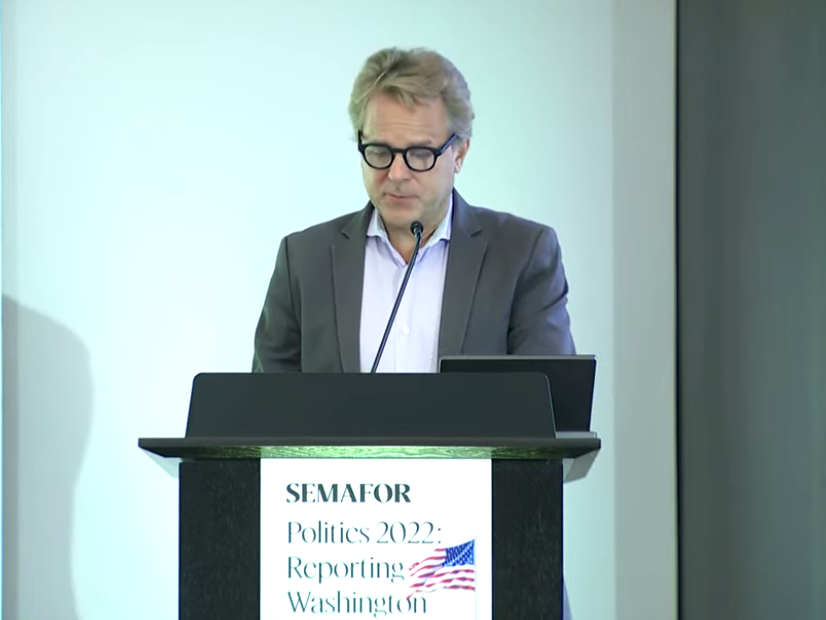
Semafor chief executive Justin B Smith has said his startup news organisation aims to “attack information overload”.
Explaining why he is setting up Semafor, Smith suggested established outlets have failed to listen to readers and innovate.
Semafor, now only weeks from launch, has kept a tight lid on what specifically it will do differently from the competition.
Smith’s comments provide slightly more insight into what he and co-founder Ben Smith (no relation) intend to do to succeed in a crowded market.
Those tactics seemingly include aggregating content from other sources, drawing on politically varied writers around the world, and using “new, more transparent article forms”.
Justin B Smith was speaking at a Semafor-organised event titled “Politics 2022: Reporting Washington”.
The former Bloomberg Media and Atlantic executive told an audience he wanted to address a question he said he was asked “on a pretty regular basis… why launch a global news company in 2022?”
He said he had become interested in “the precipitous decline in trust levels across the global news industry” and “the lack of innovation being directed at solving this existential crisis”.
He echoed previous comments by Ben Smith, who told his old employer The New York Times in January: “There are 200m people who are college educated, who read in English, but who no one is really treating like an audience.”
Justin B Smith told his Washington audience: “Intelligent news consumers, if you just stop and listen, are unhappy and are screaming from the rooftops…
“They’re overwhelmed by too much news and too many sources. It’s at an epidemic level. They no longer know which sources to trust, if any. But at the same time, they feel a deep responsibility to be extremely well-informed.”
[Read more: Justin B Smith interview – Business booms for Bloomberg Media thanks to ad ‘windfall’ and 350,000 subs]
Semafor, he proposed, will be “a global news brand dedicated to helping you manage this complexity”.
He said the organisation, which is due to launch in October, is focused on the questions: “Why can’t a global news organisation be dedicated to solving these frustrations for news consumers? Why can’t a global newsroom be reinvented to attack the problem of information overload? How could the traditional article form be reimagined to provide more transparency and therefore trust? And how can curation and distillation of other, outside sources enhance our own original content?”
Thus far, their answers to those questions were “quality original news from leading, trusted journalists”; “new, more transparent article forms”; and intelligent, comprehensive curation of other sources across the ideological and geographic spectrums”.
There was little other direct discussion of Semafor’s editorial philosophy or strategy, but other senior Semafor staff voiced opinions on what should change in journalism.
Gina Chua, Semafor’s executive editor who previously served as executive editor at Reuters, chaired a panel during the event focused on political reporting after the 6 January attack on the Capitol. Responding to an audience question about diversity in journalism, Chua pushed back against calls for broader demographic representation in newsrooms.
“It’s helpful to have more reporters of colour and more women covering things, but I think really the key issue, and the key battle, is at the editing table,” Chua said.
“That’s when news decisions get made. That’s who decides what a story is, and what stories can be told, what stories get covered. And I think that that is a really important thing – to make sure that their voice is there. And it’s not I don’t even think necessary, perhaps, to have representatives there.
“Because representation is important, but it’s not sufficient. We need to train people to have more sensitivity to issues.”
And interviewing MSNBC’s Mehdi Hasan on the subject of political debates, Ben Smith returned repeatedly to questions of whether the America’s left-right divide can be bridged.
“I actually don’t really see interviews as about winning arguments,” he told Hasan, who previously criticised Smith’s interview with the far-right Fox News host Tucker Carlson. “I see them as trying to draw people out.”
Hasan, for his part, dismissed Ben Smith’s view: “The funny thing is that journalists get such a bad rep – ‘Ah, immoral, bad people!’ I think actually journalists are like Ben [Smith] – they want to see the good in everyone! They want us to be optimistic. They want us to be able to come together. And that can be exploited, unfortunately, by bad faith actors.”
[Read more: Mehdi Hasan on making it in America and why media can’t ‘reset the clock’ on Trump]
The Smiths’ venture has been the subject of critical coverage recently, centring both on the Carlson interview and on the feasibility of the business. One Vanity Fair profile, in particular, sniped: “The few specifics that the Smiths have divulged seem relatively standard, with a recent Times profile on the venture hyping news articles ‘broken into sections distinguishing facts from opinion’ and bylines as big as headlines.”
According to a filing with the US Securities and Exchange Commission, the business had raised $24.6m (£21.4m) from 19 investors as of June.
The New York Times and Financial Times have reported those investors include cryptocurrency billionaire Sam Bankman-Fried and his brother Gabe Bankman-Fried; The Information founder Jessica Lessin; former Atlantic owner David Bradley; John Thornton, the founder of philanthropic firm the American Journalism Project; and Brazil’s richest man, Jorge Paulo Lemann.
Picture: Press Gazette screenshot of Semafor livestream
Email pged@pressgazette.co.uk to point out mistakes, provide story tips or send in a letter for publication on our "Letters Page" blog
